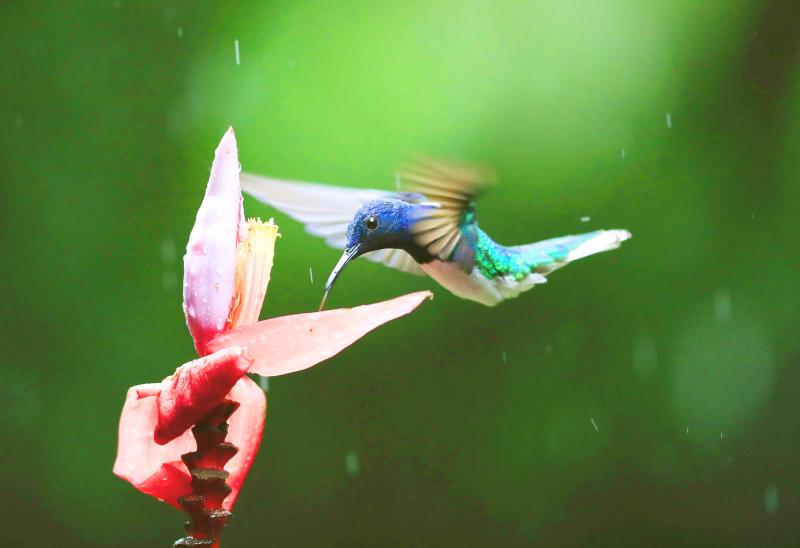Hummingbirds are not only bright in appearance but also in brain, it would seem, with new research suggesting the tiny creatures are able to understand a numerical concept of order.
While hummingbirds have previously been found to visit flowers in particular sequences when foraging, researchers say the new study suggests this process could be based on the concept of “first”, “second” and so on, rather than features such as specific flower location or nearby landmarks.
However, it does not mean that hummingbirds can count. “Counting has a more anthropocentric connotation,” said Dr Maria Tello-Ramos of the University of St Andrews, a co-author of the study. “This is more like ordering things in a sequence. We cannot say [the hummingbirds] were counting, ‘One, two, three, four,’ but that they knew that [the] fourth [flower] was different from the third flower that they encountered,” she said.

Photo: EPA-EFE 照片:歐新社
Tello-Ramos added that such a skill could help hummingbirds attach information to their foraging sequence, such as that the second flower has run out of nectar, meaning they know to skip it — even if it looks unchanged — and move on to the next in the sequence.
Some other animals that have undergone training, including rats, monkeys, bees and parrots, have previously been found able to grasp that items in a sequence can take a particular order based on an abstract numerical concept. However, the team behind the new research said their study was the first time such a capability had been shown in a wild, free-living vertebrate.
Writing in the Proceedings of the Royal Society B, Tello-Ramos and colleagues reported how they made their discovery by presenting nine male rufous hummingbirds with a row of 10 identical fake flowers on sticks spaced 20cm apart, with each flower constructed from a foam disk with a tube in the center.
To train the hummingbirds, the team filled the inner tube of the first fake flower in the row with a sugary solution. Once each hummingbird visited this flower four times in succession, the flowers were shuffled — to take account of any subtle differences between them — and the first flower in this new row was filled with a sugary solution.
The training was repeated with the sweet treat in the second, third and finally the fourth flower. The team found all the hummingbirds learned to fly to the correct flower, with the one containing the sugar visited significantly more than would be expected by chance during the training.
To check that the birds were not simply learning which flower to pick by its distance along the row, the team presented the birds with a row of randomly spaced fake flowers. The results show that the birds had a clear preference for flying straight to the flower containing the sugary solution.
Tello-Ramos said the findings added a numerical concept of order to a growing list of information that hummingbirds use to get by, including location and flower color. “If the information is relevant, the humming bird will use it,” she said.
(The Guardian)
蜂鳥不只外表光鮮亮麗,腦袋似乎也很靈光──新研究顯示,這種體型嬌小的鳥類能夠理解「順序」的數字概念。
先前的研究曾發現,蜂鳥在覓食時會以特別的先後次序拜訪花朵。研究人員表示,這份新研究指出,蜂鳥採集花蜜的過程可能是根據「第一朵」、「第二朵」這樣以此類推的概念,而不是仰賴特定花朵位置或附近地標等地理特徵。
儘管如此,這不代表蜂鳥會算數。這篇研究的共同作者、蘇格蘭聖安德魯大學的瑪麗亞‧特羅─哈摩斯指出:「『計算』這個概念帶有以人類為中心的含義。」她表示:「在蜂鳥身上發現的現象比較像是用一組順序排列物件。我們不能說[蜂鳥]正在算數,『一、二、三、四』,但是牠們知道第四[朵花]跟路上遇到的第三朵是不同的。」
特羅─哈摩斯補充說:「像這樣的能力可以幫助蜂鳥,在覓食順序中加入資訊,例如第二朵花已經沒有蜜了,代表牠們知道要跳過這朵花──就算花看起來沒有改變──然後繼續往前,飛往順序中的下一朵。」
受過訓練的其他動物,包括老鼠、猴子、蜜蜂,以及鸚鵡,先前都被發現能夠根據抽象的數字概念,理解一連串物件具有特定順序。不過,這份新研究背後的團隊指出,他們的研究是首次發現這種能力出現在獨立生存的野生脊椎動物身上。
在刊登於英國期刊《皇家學會報告生物科學版》的這篇論文中,特羅─哈摩斯和她的同事解釋獲得這項發現的過程:她們為九隻公的紅褐色蜂鳥準備一排十朵、一模一樣的假花,每朵插在間隔二十公分的枝條上。這些花是用裁成圓盤狀的泡綿做成,中間有一根管子。
為了訓練這些蜂鳥,研究團隊把含糖溶液注入第一朵假花裡面的管子。等到每隻蜂鳥都連續拜訪過這朵花四次以後,研究人員考量到假花之間可能具有細微差異,遂調換花朵順序,再把含糖溶液注入重新排列後的第一朵假花。
研究人員隨後重複這項訓練,改將甜美的糖液分別注入第二朵、第三朵,最後是第四朵花。團隊發現,受測蜂鳥全數都知道要飛往正確的花朵。內含糖水的那朵花,被蜂鳥拜訪的次數顯著多於訓練過程中可以預期的巧合。
為了確認蜂鳥不是單純以距離選擇一整排裡面的某一朵花,研究團隊也在實驗中以亂數安排假花之間的距離。結果顯示:蜂鳥有明顯的偏好,會直接飛向含有糖溶液的那朵假花。
特羅─哈摩斯表示,這項發現將「順序的數字概念」加入蜂鳥賴以為生的資訊清單中,這個清單目前仍在不斷增加,其中也包括位置和花朵顏色的訊息。她表示:「如果這項資訊是有意義的,蜂鳥就會運用它。」
(台北時報章厚明譯)

The strongest earthquake to hit Taiwan in 25 years killed at least 16 people and damaged dozens of buildings, but the destruction was largely contained thanks to decades of preparedness work. Taiwan sits on the “Ring of Fire,” an arc of intense seismic activity along the Pacific Rim, and — much like neighboring Japan — has a long history of catastrophic quakes. How does April 3 compare with other recent quakes? The April 3 earthquake, which measured 7.4 on the moment magnitude scale, was felt across Taiwan. It was the most severe since a 7.6 magnitude quake in 1999 killed

A: Artificial intelligence technology has been causing controversy lately: a student was caught cheating with AI to win the grand prize in an art contest. B: That’s so absurd. Does this mean that AI paints better than humans? A: Maybe. Luckily, the student was later disqualified. B: And more absurdly, it’s becoming more and more popular to use AI technology to “resurrect” people. A: Yeah, some netizens even posted videos featuring the late singer CoCo Lee, who was “resurrected” by them with AI software. A: 人工智慧的爭議不斷,有學生違規使用AI參加美術展,甚至贏得首獎。 B: 真誇張,這是不是代表AI比人類還強大? A: 或許吧,幸好得獎資格被取消。 B: 還有更誇張的︰讓死者重現的「AI復活」技術越來越熱門。 A: 對啊,還有網友製作已故歌后李玟「復活」的影片呢! (By Eddy Chang, Taipei Times/台北時報張聖恩)

Around the time of the Dragon Boat Festival in June, the streets of Taiwan are filled with the delightful aroma of zongzi, a traditional snack made of sticky rice wrapped in leaves. The leaves are folded into a cone and then filled with sticky rice and other ingredients such as braised pork belly, peanuts and salted duck egg yolks. The filled leaves are then tightly tied with kitchen twine and ready for cooking. 每到六月端午時節,街頭巷尾就會飄出粽子的香氣。粽子是將糯米包進粽葉的傳統美食,先將粽葉折成圓錐狀塞入糯米,以及紅燒肉、花生、鹹鴨蛋黃等配料,用棉線綁緊後即可烹煮。 Dragon Boat Festival (n. phr.) 端午節 aroma

Everyone has seen a piece of fruit turn brown after being cut. Have you ever wondered why that happens? It is a common phenomenon that occurs due to a chemical reaction called enzymatic browning. The appearance, flavor and nutritional value of the fruit are all affected by this reaction. Some fruits, such as apples, pears, bananas, avocados and peaches, are more prone to enzymatic browning than others. These fruits contain high levels of an enzyme called polyphenol oxidase, or PPO for short. __1__ This causes a chain of chemical reactions that ultimately transforms the phenolic compounds into